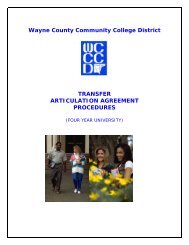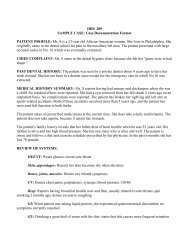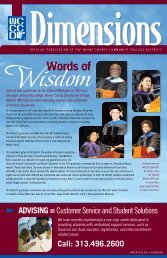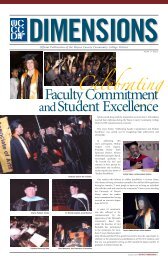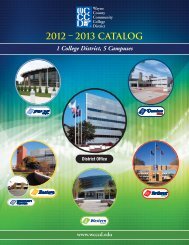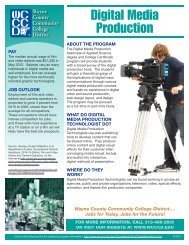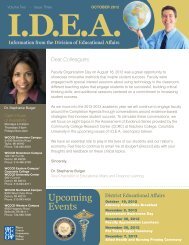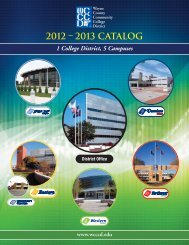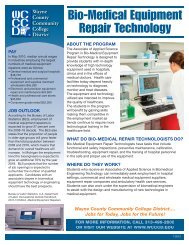to view the Student Handbook - Wayne County Community College
to view the Student Handbook - Wayne County Community College
to view the Student Handbook - Wayne County Community College
Create successful ePaper yourself
Turn your PDF publications into a flip-book with our unique Google optimized e-Paper software.
<strong>Student</strong> handbook<br />
Section: 10.0<br />
Title: student code of conduct<br />
GUIDELINES FOR SCHOLASTIC CODE OF ETHICS<br />
The expectation at <strong>Wayne</strong> <strong>County</strong> <strong>Community</strong> <strong>College</strong> District is that <strong>the</strong> principles of truth and<br />
honesty will be practiced in all academic matters. Therefore, <strong>the</strong> <strong>College</strong> regards acts of academic<br />
dishonesty, including such activities as plagiarism or cheating, as very serious offenses. In <strong>the</strong><br />
event that cheating, plagiarism or o<strong>the</strong>r forms of academic dishonesty on <strong>the</strong> part of students are<br />
discovered, each incident will be handled on an individual basis as deemed appropriate by <strong>the</strong><br />
instruc<strong>to</strong>r. Care should be taken that students’ rights are not violated and that punitive measures<br />
are instituted only in cases where documentation of one or more offenses exists. A description of all<br />
such incidents should be reported <strong>to</strong> <strong>the</strong> Chief Academic Officer where a file of such occurrences<br />
is maintained. The Chief Academic Officer may institute action against a student according <strong>to</strong><br />
procedures outlined in <strong>the</strong> <strong>Student</strong> Code of Conduct in this <strong>Student</strong> <strong>Handbook</strong>.<br />
<strong>Student</strong>s assume full responsibility for <strong>the</strong> content and integrity of <strong>the</strong> course work <strong>the</strong>y submit.<br />
The following is a guide <strong>to</strong> assist students in observing positive behavior in scholastic ethics.<br />
• <strong>Student</strong>s must do <strong>the</strong>ir own work and submit only <strong>the</strong>ir own work on examinations,<br />
reports and projects, unless o<strong>the</strong>rwise permitted by <strong>the</strong> instruc<strong>to</strong>r;<br />
• <strong>Student</strong>s can benefit from working in groups. They may collaborate or cooperate with o<strong>the</strong>r<br />
students during take-home examinations only if specifically authorized by <strong>the</strong> instruc<strong>to</strong>r in <strong>the</strong><br />
class syllabus or at <strong>the</strong> time of <strong>the</strong> examination;<br />
• <strong>Student</strong>s must follow all written and/or verbal instructions given by <strong>the</strong> instruc<strong>to</strong>r or designated<br />
<strong>College</strong> representative prior <strong>to</strong> taking an examination, placement assessments, test, quizzes<br />
and evaluations;<br />
• <strong>Student</strong>s are responsible for adhering <strong>to</strong> course requirements as specified by <strong>the</strong><br />
instruc<strong>to</strong>r in <strong>the</strong> course syllabus.<br />
SCHOLASTIC CODE OF ETHICS VIOLATIONS<br />
<strong>Student</strong>s enrolled in college assume <strong>the</strong> obligation of conducting <strong>the</strong>mselves in accordance with<br />
<strong>the</strong> highest ethical standards. Actions constituting violations of scholastic ethics include, but are not<br />
limited <strong>to</strong> <strong>the</strong> following:<br />
CHEATING<br />
Intentional deceit during <strong>the</strong> pursuit of academic course work, tests, class assignments or activities<br />
in any testing area, learning center, clinical setting or tu<strong>to</strong>rial session, or in <strong>the</strong> ga<strong>the</strong>ring of research<br />
materials is considered cheating. Cheating includes but is not limited <strong>to</strong>:<br />
• Copying from ano<strong>the</strong>r student’s test paper or knowingly allowing your test <strong>to</strong> be copied;<br />
• Using materials during a test that are not clearly authorized by <strong>the</strong> person giving <strong>the</strong> test;<br />
• Collaborating with ano<strong>the</strong>r student during <strong>the</strong> test without permission;<br />
• Knowingly using, buying, selling, offering, transporting or soliciting any of <strong>the</strong> contents of a test;<br />
• Taking a test for ano<strong>the</strong>r person, or permitting ano<strong>the</strong>r student <strong>to</strong> take a test for you;<br />
• Bribing or attempting <strong>to</strong> bribe ano<strong>the</strong>r person <strong>to</strong> obtain a passing grade or a better<br />
grade on a test or for a course;<br />
• Intentional misconstruing facts or incidents relating <strong>to</strong> an evaluated exercise or<br />
assignment that would change <strong>the</strong> earned grade;<br />
• Electronic, internet transmissions or wireless transfer of data.<br />
PLAGIARISM<br />
The representation of <strong>the</strong> work of o<strong>the</strong>rs as one’s own, including <strong>the</strong> use of term papers written by<br />
o<strong>the</strong>rs, is plagiarism. The use of ano<strong>the</strong>r’s words, ideas or information without acknowledgement is<br />
also plagiarism. The student should seek guidance from <strong>the</strong> instruc<strong>to</strong>r about acceptable methods <strong>to</strong><br />
be used <strong>to</strong> acknowledge <strong>the</strong> work and ideas of o<strong>the</strong>rs.<br />
Page 41



